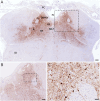Anti-IgLON5 Disease 10 Years Later: What We Know and What We Do Not Know
- PMID: 39705634
- PMCID: PMC11666276
- DOI: 10.1212/NXI.0000000000200353
Anti-IgLON5 Disease 10 Years Later: What We Know and What We Do Not Know
Abstract
Anti-IgLON5 disease was identified 10 years ago, thanks to the discovery of IgLON5 antibodies and the joint effort of specialists in sleep medicine, neuroimmunology, and neuropathology. Without this collaboration, it would have been impossible to untangle fundamental aspects of this disease. After the seminal description in 2014, today there is growing evidence that most patients present a chronic progressive course with gait instability, abnormal movements, bulbar dysfunction, and a sleep disorder characterized by nonrapid eye movement and REM parasomnias, and obstructive sleep apnea with stridor. Unlike other autoimmune encephalitides, the response to immunotherapy is suboptimal. Neuropathologic studies in patients with a prolonged clinical course showed a novel 3-repeat and 4-repeat neuronal tauopathy mainly involving the hypothalamus and tegmentum of the brainstem. The absence of tau deposits in the brain of patients who died early, the demonstration that IgLON5 antibodies cause an irreversible decrease in cell-surface levels of IgLON5, and a disorganization of the neuronal cytoskeleton suggest that the disease is primarily autoimmune and the tauopathy a secondary event. After a decade, we now know the disease much better, but important issues still need to be addressed. We have to gather more information on the natural course of the disease, develop better treatments, and identify robust predictors of outcome. More basic research is needed on the physiology of IgLON5, how antibodies disrupt its function, and the downstream effects leading to neurodegeneration. Finally, better designed passive transfer and active immunization models are needed to confirm the pathogenic effect of IgLON5 antibodies.
Conflict of interest statement
F. Graus receives royalties from Euroimmun for the use of IgLON5 as an autoantibody test and honoraria for Associate Editor of MedLink Neurology. J.O. Dalmau receives royalties from Athena Diagnostic for use of Ma2 as an autoantibody test and from Euroimmun for use of NMDA receptor, GABAB receptor, GABAA receptor, DPPX, and IgLON5 as autoantibody tests. All other authors report no relevant disclosures. Go to
Figures



References
-
- Sabater L, Gaig C, Gelpi E, et al. . A novel non-rapid-eye movement and rapid-eye-movement parasomnia with sleep breathing disorder associated with antibodies to IgLON5: a case series, characterisation of the antigen, and post-mortem study. Lancet Neurol. 2014;13(6):575-586. doi:10.1016/S1474-4422(14)70051-1 - DOI - PMC - PubMed
Publication types
MeSH terms
Substances
LinkOut - more resources
Full Text Sources
